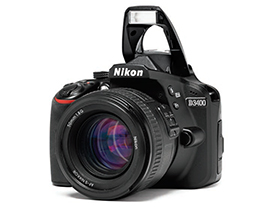 Entry-level D-SLRs are the most sought after because of their affordability, and Nikon D3000- series has been one of the best sellers. After a successful run of close to three years, the D3300 was screaming for an upgrade, and Nikon has responded by giving it a new lease of life as D3400. Let us see what are the new life-prolonging upgrades Nikon has incorporated in this camera.
Entry-level D-SLRs are the most sought after because of their affordability, and Nikon D3000- series has been one of the best sellers. After a successful run of close to three years, the D3300 was screaming for an upgrade, and Nikon has responded by giving it a new lease of life as D3400. Let us see what are the new life-prolonging upgrades Nikon has incorporated in this camera.
Design and Build Quality
The D3400 carries the same build quality as that of the D3300, which is expected of a budget D-SLR. The exterior is built of engineering plastic and the body is quite light. The LCD is fixed, and nothing has changed from the previous version. The hand grip has a textured rubber finish. The only visual difference as far as we could perceive was the Bluetooth logo on the left side above the interface slots. Both the lens mount and the tripod receptacle are metal.
Key Features
The Nikon D3400 has not many critical changes from the D3300 and hence a tabulated form of feature comparison would seem ridiculous. The camera features the same DX format (23.5 x 15.6mm) 24.2 megapixel CMOS sensor, but the ultrasonic dust reduction system has been removed, probably to cut production cost and make the battery last more. The same EXPEED 4 image processor finishes the images and it accepts Nikon AF-S and AF-P lenses in full compatibility, while other lenses will not autofocus.
The camera uses an eye-level pentamirror single-lens reflex viewfinder with diopter adjustment function and a Type B BriteView Clear Matte Mark VII focussing screen. The D3400 uses an electronically-controlled vertical-travel focal-plane shutter providing shutter speeds from 30 to 1/4000 sec along with Bulb and Time modes. The flash synchronises with the shutter at 1/200 sec or slower speeds. Drive modes include S (Single), C (Continuous), Q (Quiet shutterrelease), Self-timer and Remote. The 3400 can shoot at a maximum continuous speed of five frames per second. Shooting modes available are Auto (auto; auto, flash off ), Programmed auto with flexible program (P), Shutter-priority auto (S), Aperture-priority auto (A), Manual (M), Scene and, Special Effects. Scene modes provide options of Portrait, Landscape, Child, Sports, Close-up and Night portrait. Special effects include Night vision, Super vivid, Pop, Photo illustration, Toy camera effect, Miniature effect, Selective colour, Silhouette, High key and Low key.
The D3400 uses Nikon Multi-CAM 1000 autofocus sensor module with TTL phase detection. It utilises a total of 11 focus points including one cross-type sensor at the centre. The AF system is capable of operating from –1 to +19 EV at ISO 100. During Live View, the camera uses contrast detect autofocus.
Lens servo options available are Singleservo (AF-S), Continuous-servo (AF-C), Auto AF-S/AF-C selection (AF-A) and Manual focus (MF). AF-area modes include Single-point, Dynamic-area, Auto-area and 3D-tracking.
The 3400 features TTL exposure metering using main image sensor and the metering modes include Matrix, Centre-weighted and Spot. Exposure can be compensated up to +/-5 EV in steps of 1/3 EV. ISO sensitivity ranges from ISO 100 to 25,600 along with an Auto setting. This is one stop more than the D3300, but does it really matter? The built-in flash has been downgraded and now has a Guide Number of 7m at ISO 100, down from 12m on the D3300. Flash is controlled using i-TTL flash control with a 420-pixel RGB sensor. Flash modes include Auto, Auto with red-eye reduction, Auto slow sync, Auto slow sync with red-eye reduction Fill-flash, Red-eye reduction, Slow sync, Slow sync with red-eye reduction, Rearcurtain with slow sync, Rear-curtain sync and Off. Flash exposure can be compensated by -3 to +1 EV in steps of 1/3 EV. The camera also has an ISO 518 hot-shoe with sync and data contacts and safety lock.
The 3400 provides White Balance options such as Auto, Incandescent, Fluorescent (7 types), Sunlight, Flash, Cloudy, Shade and Preset Manual. All except preset manual can be finetuned. Still images are recorded in Raw or JPEG format and the option exists to record both simultaneously at a maximum size of 6000 x 4000 pixels. Self-timer provides 2, 5, 10 or 20 sec delay options for up to nine exposures. Videos are recorded with a maximum size of 1920 x 1080 (Full HD) at 60p, 50p, 30p, 25p or 24p in MOV format.
The camera incorporates a 3-inch TFT LCD with 170 ° viewing angle and approximately 100% frame coverage. It has a resolution of approximately 921 k-dots (VGA). The 3400 uses a single SD/ SDHC/SDXC (UHS-I compliant) card for storage. The camera interface provides a Hi-Speed USB with Micro-USB connector and HDMI output connector. The 3400 uses Bluetooth and SnapBridge for wireless communication, but we have no clue why Nikon chose Bluetooth over WiFi to transfer output from a 24-MP D-SLR. It could again be for power saving. The 3400 is powered by an EN-EL14a rechargeable Li-ion battery (supplied). The camera measures 124 x 98 x 75.5 mm and weighs 445 g with battery and memory card.

